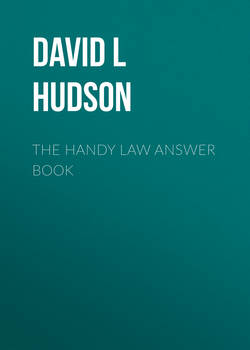Читать книгу The Handy Law Answer Book - David L Hudson - Страница 32
На сайте Литреса книга снята с продажи.
What is separation of powers?
ОглавлениеSeparation of powers refers to the division of power among different parts of government. The U.S. Constitution reflects this principle by dividing power between the legislative, executive, and judicial branches. If one branch of government invades the province of another branch of government, then that branch has violated the separation of powers principle.
The Framers understood that dividing power among the different branches of government would ensure that no single branch would become too powerful. This concept is known as the separation of powers. Many of the Founding Fathers understood the importance of separating powers between the branches of government. Many of them had read the French philosopher the Baron de Montesquieu’s L’Esprit des Lois (“The Spirit of the Laws”), which addressed this principle.
Madison in the Federalist Papers described Montesquieu as “the oracle who is always consulted and cited on this subject.” Madison described the principle as: “The accumulation of all powers, legislative, executive and judiciary, in the same hands, whether of one, a few, or many, and whether hereditary, self-appointed, or elective, may justly be pronounced the very definition of tyranny.” Separation of powers is a philosophy in which each branch has its own powers. U.S. Supreme Court Justice Anthony Kennedy explains: “Separation of powers was designed to implement a fundamental insight: Concentration of power in the hands of a single branch is a threat to liberty.”
Our Constitution adheres to this principle. The powers of Congress are described in Article I. The powers of the executive branch are detailed in Article II, and the powers of the judicial branch are listed in Article III.
This principle is important in not only the federal government but also state governments. For example, state judicial branches traditionally have regulated lawyers. If a state legislature passes a law regulating the conduct of lawyers, such a law may violate the separation of powers principle. In this example, the legislative branch has invaded the province of the judicial branch.
The Constitution attempts to ensure separation of powers by instituting a system of checks and balances between the different branches of government. Each branch has a check on the other two branches. For example, the judicial branch has a check on Congress, because it can declare laws or bills passed by Congress unconstitutional. Similarly, the judicial branch has a check on the president because it can also declare executive acts unconstitutional.
